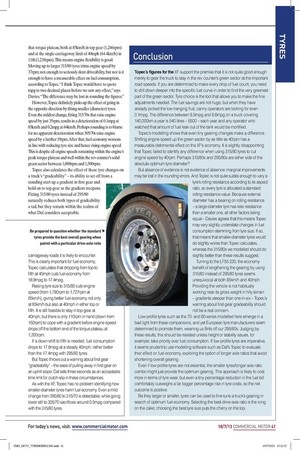Conclusion Topec's figures for the XF support the premise that
Page 33

If you've noticed an error in this article please click here to report it so we can fix it.
it is not quite good enough merely to gear the truck to stay in the rev counter's green sector at the important road speeds. If you are determined to make every drop of fuel count, you need to drill down deeper into the specific fuel curve in order to find the very greenest part of the green sector. Tyre choice is the tool that allows you to make the fine adjustments needed. The fuel savings are not huge, but when they have already picked the low-hanging fruit, canny operators are looking for even 0.1mpg. The difference between 8.5mpg and 8.6mpg on a truck covering 140,000km a year is 540 litres — £600 — each year and any operator who watched that amount of fuel leak out of the tank would be mortified.
Topec's modelling shows that even tiny gearing changes make a difference. Shifting engine speed up the green sector by as little as 40rpm has a measurable detrimental effect on the XF's economy. It is slightly disappointing that Topec failed to identify any difference when using 315/80 tyres to cut engine speed by 40rpm. Perhaps 315/80s and 295/80s are either side of the absolute optimum tyre diameter?
But absence of evidence is not evidence of absence: marginal improvements may be lost in the rounding errors. And Topec is not quite subtle enough to vary a tyre's rolling resistance according to its aspect ratio, so every tyre is allocated a standard rolling-resistance value. Because external diameter has a bearing on rolling resistance — a large-diameter tyre has less resistance than a smaller one, all other factors being equal — Davies agrees that this means Topec may very slightly understate changes in fuel consumption stemming from tyre size. If so, that means that smaller-diameter tyres would do slightly worse than Topec calculates, whereas the 315/80s we modelled should do slightly better than these results suggest.
Turning to the LF55.220, the economy benefit of lengthening the gearing by using 315/80 instead of 295/80 tyres seems unequivocal at both 85km/h and 40mph. Providing the vehicle is not habitually working near its gross weight in hilly terrain — gradients steeper than one-in-six — Topec's warning about first gear gradeability should not be a real concern.
Low-profile tyres such as the 70and 60-series modelled here emerge in a bad light from these comparisons, and yet European tyre manufacturers seem determined to promote them, weaning us Brits off our 295/80s. Judging by these results, this should be resisted unless height or stability issues, for example, take priority over fuel consumption. If low-profile tyres are imperative, it seems prudent to use modelling software such as Daf's Topec to evaluate their effect on fuel economy, exploring the option of longer axle ratios that avoid shortening overall gearing.
Even if low-profile tyres are not essential, the smaller tyres/longer axle ratio combo might just provide the optimum gearing. This approach is likely to cost more in terms of tyre wear, but even a tiny percentage reduction in the fuel bill comfortably outweighs a far bigger percentage rise in tyre costs, so the net outcome is positive.
Be they larger or smaller, tyres can be used to fine-tune a truck's gearing in search of optimum fuel economy. Selecting the best drive-axle ratio is the icing on the cake; choosing the best tyre size puts the cherry on the top.








































